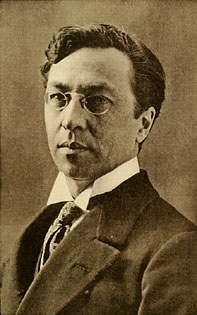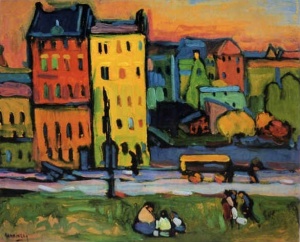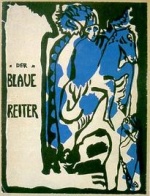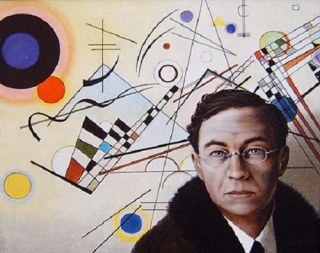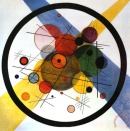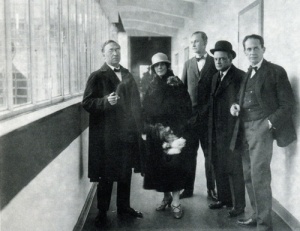Wassily Kandinsky: Difference between revisions
No edit summary |
No edit summary |
||
| Line 3: | Line 3: | ||
[[File:Wassily Kandinsky portrait.jpeg|220px|right|thumb|Wassily Kandinsky]] | [[File:Wassily Kandinsky portrait.jpeg|220px|right|thumb|Wassily Kandinsky]] | ||
[[File:Kandinsky - Houses in Munich - 1908.jpg|300px|right|thumb|''House in Munich'', 1908]] | [[File:Kandinsky - Houses in Munich - 1908.jpg|300px|right|thumb|''House in Munich'', 1908]] | ||
'''Wassily Kandinsky''' (Russian: Васи́лий Васи́льевич Канди́нский) was a Russian abstract expressionist painter who was heavily influenced by [[Theosophy]]. He wrote a hugely influential book, '''''Concerning the Spiritual in Art''''', and taught at the Bauhaus. | |||
'''Wassily Kandinsky''' (Russian: Васи́лий Васи́льевич Канди́нский) was a Russian abstract expressionist painter | |||
== Early life and education == | == Early life and education == | ||
| Line 17: | Line 16: | ||
<br> | <br> | ||
[[File:Kandinsky Composition VIII - 1923.jpg|320px|right|thumb|''Kandinsky and ''Composition VIII'', 1923]] | [[File:Kandinsky Composition VIII - 1923.jpg|320px|right|thumb|''Kandinsky and ''Composition VIII'', 1923]] | ||
=== ''Concerning the Spiritual in Art'' === | |||
=== Famous paintings === | === Famous paintings === | ||
| Line 32: | Line 31: | ||
The Bauhaus offered a position in its faculty, and Kandinsky worked there from 1923-1933, when the school was closed by the Nazis. Several other people associated with the Bauhaus were Theosophists or highly influenced by Theosophy, including [[Paul Klee]], [[Johannes Itten]], and [[Alma Mahler Gropius Werfel]], the widow of [[Gustav Mahler]] who had married Bauhaus founder Walter Gropius. After the school closed, Kandinsky moved to Paris, and lived there until his death on [[December 13]], 1944. | The Bauhaus offered a position in its faculty, and Kandinsky worked there from 1923-1933, when the school was closed by the Nazis. Several other people associated with the Bauhaus were Theosophists or highly influenced by Theosophy, including [[Paul Klee]], [[Johannes Itten]], and [[Alma Mahler Gropius Werfel]], the widow of [[Gustav Mahler]] who had married Bauhaus founder Walter Gropius. After the school closed, Kandinsky moved to Paris, and lived there until his death on [[December 13]], 1944. | ||
=== Writings === | |||
* '''''Über das Geistige in der Kunst'''''. | |||
** '''''Concerning the Spiritual in Art''''' . | |||
**Edited and translated by Hilla Rebay (New York: Solomon R. Guggenheim Foundation, 1946), for the Museum of Non-Objective Painting. Available at [https://archive.org/details/onspiritualinart00kand Internet Archive]. 164 pages, with color plates and other illustrations. | |||
**Dover Edition translated and with introduction by M. T. H. Sadler (New York: Dover Publications, 1977). 57 pages with black-and-white illustrations. | |||
* '''''The Art of Spiritual Harmony'''''. Translated into English by Michael Sadler (London: Constable and Company Limited, 1914; also Boston and New York: Houghton Mifflin Company, 1914.) Available at [https://archive.org/details/artofspiritualha00kandrich Internet Archive]. | |||
* '''''Punkt und linie zu flache''''' | |||
**'''''Point and Line to Plane: Contribution to the Analysis of the Pictorial Elements'''''. Translated by Howard Dearstyne and edited by Hilla Rebay. New York: Solomon R. Guggenheim Foundation, 1947. Available at [https://archive.org/details/pointlinetoplane00kand Internet Archive]. 226 pages. | |||
== Influence of Theosophy == | == Influence of Theosophy == | ||
Revision as of 17:01, 2 January 2017
UNDER CONSTRUCTION
UNDER CONSTRUCTION
Wassily Kandinsky (Russian: Васи́лий Васи́льевич Канди́нский) was a Russian abstract expressionist painter who was heavily influenced by Theosophy. He wrote a hugely influential book, Concerning the Spiritual in Art, and taught at the Bauhaus.
Early life and education
Wassily Wassilyevich Kandinsky was born on December 4, 1866 in Moscow. His father, a wealthy tea merchant, was from an aristocratic family. In 1871 Wassily's family moved to the Crimea, and the boy attended school in Odessa. He excelled in his studies, and returned to Moscow in 1886 to study law and political economy. After he was awarded a degree in 1892, he taught jurisprudence at Moscow university. His career path in academia seemed to be well established when he "turned down the offer of a professorship at the University of Dorpat in Estonia and went instead to Munich to study painting."[1] As a young boy he had always loved music and art - playing piano and cello, and painting in oils. "Art and music, ranging from traditional Russian religious icons and Rembrandt oils to a performance of Wagner's Lohengrin, left profound impressions on him... An 1895 Moscow exhibit exposed Kandinsky to the French Impressionists, and his feelings upon seeing Monet's Haystack seemed to predict the destiny that awaited him."[2]
Artistic career
Because young artists in Munich in the 1890s were exploring abstract, primitive, oriental, and medieval styles in the Jugendstil movement, Kandinsky had the opportunity to move in avant-garde art circles while he pursued traditional training. In 1901 he broke away from the academy to form an artists' association called the Phalanx which gave him an outlet for exhibition. He also gained experience in teaching art and built a reputation that helped him into major exhibitions like the 1902 Berlin Secession and the Salon d'Automne in Paris in 1904. He began to travel to Germany, Italy, Holland, Tunisia, and France during 1903-1908, and developed his own style. Back in Munich, "the impact of the Fauvist color, combined with a primitiveness and directness attributable to his Russian heritage, the artist began producing major expressionist landscape paintings." He organized the Neue Künstler Vereinigung [NKV, the New Artists' Association] in a revolt against the Munich Secession. After 1911, his continued movement toward abstraction led to a split in the group, and Kandinsky, with Franz Marc, formed Der Blaue Reiter [the Blue Rider]. They published a journal, called an almanac, that emphasized spiritual reality expressed in diverse styles of art. During this same period, Kandinsky was writing his Über das Geistige in der Kunst, or Concerning the Spiritual in Art, which was published in 1911.[3]
Concerning the Spiritual in Art
Famous paintings
Bauhaus
The Bauhaus offered a position in its faculty, and Kandinsky worked there from 1923-1933, when the school was closed by the Nazis. Several other people associated with the Bauhaus were Theosophists or highly influenced by Theosophy, including Paul Klee, Johannes Itten, and Alma Mahler Gropius Werfel, the widow of Gustav Mahler who had married Bauhaus founder Walter Gropius. After the school closed, Kandinsky moved to Paris, and lived there until his death on December 13, 1944.
Writings
- Über das Geistige in der Kunst.
- Concerning the Spiritual in Art .
- Edited and translated by Hilla Rebay (New York: Solomon R. Guggenheim Foundation, 1946), for the Museum of Non-Objective Painting. Available at Internet Archive. 164 pages, with color plates and other illustrations.
- Dover Edition translated and with introduction by M. T. H. Sadler (New York: Dover Publications, 1977). 57 pages with black-and-white illustrations.
- The Art of Spiritual Harmony. Translated into English by Michael Sadler (London: Constable and Company Limited, 1914; also Boston and New York: Houghton Mifflin Company, 1914.) Available at Internet Archive.
- Punkt und linie zu flache
- Point and Line to Plane: Contribution to the Analysis of the Pictorial Elements. Translated by Howard Dearstyne and edited by Hilla Rebay. New York: Solomon R. Guggenheim Foundation, 1947. Available at Internet Archive. 226 pages.
Influence of Theosophy
Kandinsky was never a member of any Theosophical society, but read extensively in Theosophical concepts, including the seminal work The Secret Doctrine by Helena Petrovna Blavatsky.
Wassily Kandinsky was an avid student of occult and mystical teachings. Theosophy provided the main structure for his lessons in spirituality, but he certainly enriched his studies with other material. As his spiritual awareness evolved, so too did his art. Ideals that he was previously content to express in Symbolist form, later shed their casings as they expanded through abstraction. As Theosophical teachings on thought forms and the correlation between vibrations, color, and sound influenced his work, he began to rely very little on form. Shape, line, and color became his main tools for creating a visible image of unseen events in the astral world.[5]
He quoted Blavatsky's The Key to Theosophy in writing about the methods used by primitive and ancient cultures in dealing with matters that cannot be explained by materialistic science.
These methods are still alive and is use among nations whom we, from the height of our knowledge, have been accustomed to regard with pity and scorn. To such nations belong the Indians, who from time to time confront those learned in our civilization with problems which we have either passed by unnoticed or brushed aside with superficial words and explanations [such as hypnotism]. Mme. Blavatsky was the first person, after a life of many years in India, to see a connection between these "savages" and our "civilization." From that moment there began a tremendous spiritual movement which today includes a large number of people and has even assumed a material form in the Theosophical Society. This society consists of groups who seek to approach the problem of the spirit by way of the inner knowledge... Theosophy, according to Blavatsky, is synonymous with eternal truth. "The new torchbearer of truth will find the minds of men prepared for his message, a language ready for him in which to clothe the new truths he brings an organization awaiting his arrival, which will remove the merely mechanical, material obstacles and difficulties from his path." And then Blavatsky continues, "The earth will be a heaven in the twenty-first century in comparison with what it is now." and with these words ends her book.[6]
The 1905 book Thought Forms by Theosophists Annie Besant and Charles Webster Leadbeater clearly had a major impact on Kandinsky's thinking when he wrote Concerning the Spiritual in Art:
[the influence of Theosophical writers] was far greater at this crucial juncture in his development than the artist could bring himself to disclose at the time. His entire Weltanschauung, his worldview of life itself, was shaped by their philosophy of the occult...
On the Spiritual in Art is, after all, a treatise on the aesthetics of painting, and a good many of what appear to be purely aesthetic observations—about form, about color, about spatial relationships—are similarly derived from theosophical pronouncements. In this respect, Thought-Forms — the theosophical classic by Annie Besant and C. W. Leadbeater that was translated into German in 1908— seems to have been of capital importance. When, for example, in the chapter of On the Spiritual devoted to “The Language of Forms and Colors,” Kandinsky sets about the task of assigning specific meanings to specific colors, he is clearly appropriating an occult practice.
Thus about the color blue, Kandinsky writes that “the deeper the blue becomes, the more strongly it calls man toward the infinite, awakening in him a desire for the pure and, finally, the supernatural”—an obvious echo of the assertion in Thought-Forms that “the different shades of blue all indicate religious feeling.” When he writes about green that “pure green is to the realm of color what the so-called bourgeoisie is to human society: it is an immobile, complacent element, limited in every respect,” this description, too, bears a distinct resemblance to the statement in Thought-Forms that “green seems always to denote adaptability; in the lowest case, when mingled with selfishness, this adaptability becomes deceit,” etc. And while it is true that Kandinsky takes certain liberties with this theosophical practice, deviating from some of the meanings assigned to colors in Thought-Forms and other occult writings, he nonetheless follows the practice of conferring upon each color a significance that is finally metaphysical.[7]
Later years
Additional resources
The Union Index of Theosophical Periodicals lists 9 articles by or about Kandinsky.
- WassilyKandinsky.net offers 511 paintings, 91 photos, biography, books, videos, quotations, and more.
- Wassily Kandinsky Natal Horoscope at Khaldea.
Articles
- Art, Theosophy, and Kandinsky by John Algeo
- Kandinsky's Thought Forms and the Occult Roots of Modern Art by Gary Lachman
- Kandinsky and Theosophy by Catherine Wathen
Video
- Kandinsky, Spiritual Insight, and Abstract Art by Dan Noga
Notes
- ↑ Richard Stratton, "Preface to the Dover Edition" Concerning the Spiritual in Art (New York: Dover, 1972), v.
- ↑ Richard Stratton, "Preface to the Dover Edition" Concerning the Spiritual in Art (New York: Dover, 1972), v.
- ↑ Richard Stratton, "Preface to the Dover Edition" Concerning the Spiritual in Art (New York: Dover, 1972), vi-viii.
- ↑ Mikey Smith, "Wassily Kandinsky: 8 of the Abstract Painter's Most Famous Works and Facts about His Life" Daily Mirror December 16, 2014 on Daily Mirror website.
- ↑ Kathleen Hall "Theosophy and the Emergence of Modern Abstract Art" Quest 90.3 (May-June 2002).
- ↑ Wassily Kandinsky Concerning the Spiritual in Art (New York: Dover, 1977), 13-14.
- ↑ Hilton Kramer "Kandinsky & the Birth of Abstraction" The New Criterion 35.4 (December 2016). From Features, March, 1995. Available at New Criterion website.
